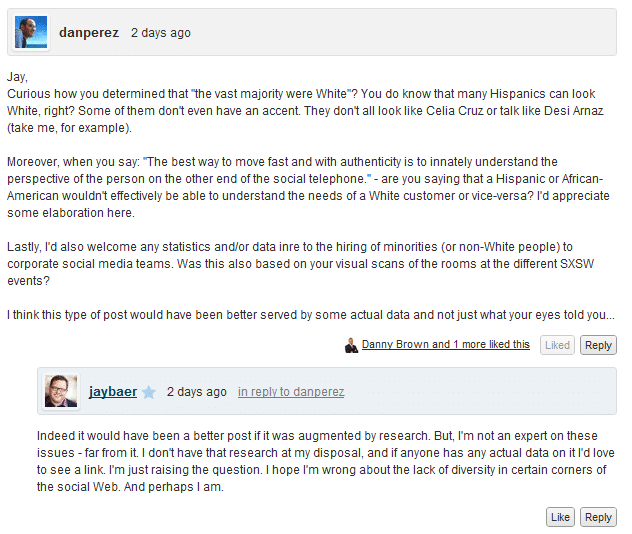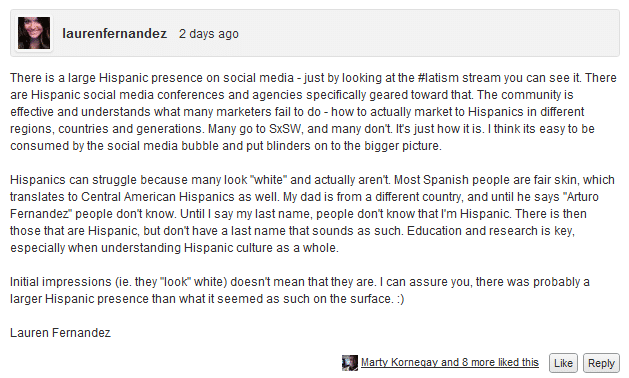
Over at his excellent Convince and Convert blog, Jay Baer shares a post on whether it seemed?white folks are the majority in social media. This feeling is based on his experience at the recent South by Southwest festival, where he noticed that the majority of people in his session were white. From Jay’s post:
“As I looked around at these events, I noticed that the vast majority of attendees appeared to be 25-39 years old (I?m actually an old fart in social media circles), and?the vast majority were White. The fact is, most social media pros can easily name the handful of people of color in the business. Excellent professionals like?Wayne Sutton,?Stanford Smith,?Shashi Bellamkonda,?Shama Kabani, and?Rohit Bhargava are the exceptions that prove the rule.”
(Update – Jay wasn’t referring to his sessions in his post. It should have said “events”, and not “his session”. My apologies.)
Jay’s post goes on to ask why there isn’t more diversity in social media, and that “we have to do more than rely on a bunch of 30 year old white people” for our social media information. Again, from Jay’s post with regards diversity:
“Consequently, I do believe?companies need to consider proactively adding diversity to their social media teams, to ensure that first responder and content creation teams understand the perspectives of all customers and potential customers.”
The post is an interesting read, and opens up a great discussion in the comments.
To me, though, the post misses a key point (which, to be fair, Jay addresses afterwards in the comments): there are no statistics in Jay’s post to back up his view.
While Jay’s post is a great conversation starter, the lack of statistics mean it’s still restricted.
Numbers Make a Difference
While it might look like there’s a distinct lack of diversity from the folks that were at the SxSW events in question, that’s possibly more to do with South by Southwest (or any event) than colour. It’s up to organizers to make sure that diversity is key, and I’ve heard more than one story of how the SxSW panel picking is skewed towards friends over non-biased choice.
Ignoring the South by Southwest example for now, Jay mentions in a reply to Dan Perez (who asked about statistical proof) that he didn’t have any research at hand.

The thing is, there’s a ton of research and statistics available if you do the grunt work.
If you drop over to BlackWeb 2.0, for example, you’ll find an excellent resource that’s leading the way in highlighting blacks in technology and new media. When they shared their take on a 2009 Pew Report, they showed that seven out of ten African Americans used Twitter as opposed to six in ten white people.
Additionally, their social web category shares how black people and businesses are using social media.
Over at ColorLines, which offers analysis and solutions to racial justice issues, they extend on that report a little further, and show that 13% of black internet users are on Twitter; 18% of Latin American internet users are on Twitter; but only 5% of white internet users are.
Of course, social media is much more than just Twitter. Blogging, for example, is one of the lead platforms on the social web for sharing a view and making yourself heard, and there’s no shortage of quality black bloggers online.
Over at Squidoo, for instance, there’s a lens that shares 50 of the top African Amercian blogs for black men. These range from business blogs to fatherhood blogs, political blogs and more. It’s a great list and well worth checking out (a similar one for women would be great!).
At Blogged.com, there’s also a sub-category in the Society section that covers African American blogs, and these range from feminist blogs to pop culture, as well as the issues of dealing with infertility. Again, it’s another great resource and shows how black social media users are using the platform every day.
Not Just Black and White
Stepping away from just black and white social media use in the U.S., the Hispanic and Latino movement is anything but minority, too.
I mentioned Dan Perez earlier, who’s Hispanic, and the comment he left on Jay’s post. Lauren Fernandez, an awesome Cuban PR pro, raised a great point about Latino and Hispanic use of social media in her comment:

Both Lauren and Dan make a great point in their comments about it not always being easy to tell someone’s race or culture based on their appearance. It’s something we’re all guilty of, and leads to a lot of incorrect assumptions that can trip us up further down the road.
A report from January 2011 over at Fox News Latino shows how Latinos are using the social web for good, as well as highlighting that Hispanics are embracing technology faster than any other demographic, despite being in the minority.
Then you have the likes of Manoj Nigam, VO of IT at Vodafone, Manish Mehta, VP Global Online for Dell, and Viraj Patel, VP of IT at BigTree Entertainment, showing businesses how they can take their companies to Wall Street with social media.
If you want a really impressive number, then the fact that 39% of Chinese sales consultants use social media to engage their customers compared to only 3% of U.S. sales consultants is pretty telling. At Asian Nation, you can find all sorts of reports, statistics, communities and more dedicated to Asian America today.
It’s Not the People
These are just some resources and stats that I found while researching around the topic of Jay’s post. While Jay’s right in that it always seems to be the same people at the same events, that skews things a bit because these people just happen to be (primarily) white.
They’re also the folks that Jay would cite as leaders in social media. Other people (myself included) would probably cite very different people and names – because that’s a natural thing to do. We always think of those we connect with most when asked about something, as opposed to taking the better route and thinking of those that are also doing really great things, but without the fanfare that Jay’s Mafia would probably get.
That doesn’t mean that white folks are dominating social media, nor does it mean there’s a lack of cultural diversity in social media.
It just means the industry needs to do a better job at recognizing people that aren’t part of the “inner circle”, if you like, and stop using “names” just to sell seats.
If you really want diversity, you first have to highlight it – the rest will fall into place naturally. So, how about it, event organizers and blog thought leaders – a bit more elbow work to let these new voices heard would be a good start, no?
And how about you? Who’s doing great things online and isn’t white? Let’s start the highlighting now – sound good?
image: Rose Cioccolato
